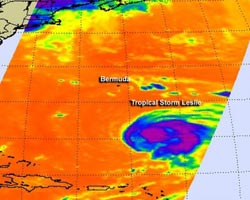NASA sees Tropical Storm Leslie was causing a problem for itself

NASA's Aqua satellite flew over Tropical Storm Leslie on Sept. 5 at 0611 UTC (2:11 a.m. EDT) and noticed the strongest convection (purple) and coldest cloud top temperatures in a large area surrounding the center of circulation and in a band of thunderstorms to the east of the center. Leslie swept up cooler waters from below the surface on its slow track that slowed the storm's ability to strengthen.<br><br>Credit: NASA JPL, Ed Olsen<br>
Tropical Storm Leslie has been on a slow track in the Atlantic, and because of that, the storm is kicking up cooler waters from below the ocean surface.
Those cooler waters were seen in infrared imagery on Sept. 5 at 0611 UTC (2:11 a.m. EDT) taken by the Atmospheric Infrared Sounder (AIRS) instrument that flies aboard NASA's Aqua satellite.
The cooler waters are responsible for Leslie's slow strengthening. Sea surface temperatures need to be at least as warm as 80 degrees Fahrenheit (26.6 Celsius) to maintain a tropical cyclone. When a tropical cyclone moves slowly, however, it churns up the waters below the surface, which are cooler. That cooler water saps the tropical cyclone's strength.
Infrared satellite data from NASA's AIRS instrument has often seen a “cold water wake” trailing behind a tropical cyclone. That's the cold water drawn up to the ocean's surface as the tropical cyclone passes by.
If there's another tropical cyclone behind the one that stirs up the deeper, cooler, ocean water, the second storm tends to weaken in the cold water wake.
Other than cool sea surface temperatures, Leslie has been battling wind shear, which has kept the storm below hurricane strength so far. That's changing, though, as the vertical shear has been gradually decreasing today, Sept. 5. As a result of the weaker wind shear, forecasters at the National Hurricane Center noticed a “banding eye feature” in visible satellite imagery.
The AIRS data of Tropical Storm Leslie confirmed the visible imagery. AIRS infrared data showed the strongest convection (rising air that forms thunderstorms) and coldest cloud top temperatures were in a large area surrounding the center of circulation and in a band of thunderstorms to the east of the center.
On Sept. 5 at 11 a.m. EDT, Leslie was close to hurricane strength with maximum sustained winds near 70 mph (110 kmh). Leslie is expected to reach hurricane status later in the day as the wind shear eases. Leslie's center was about 470 miles (760 km) south-southeast of Bermuda, near latitude 25.7 north and longitude 62.8 west. Leslie is moving toward the north near 2 mph (4 kmh).
Leslie is expected to continue crawling and wobbling to the north and north-northwest over the next couple of days because it is being blocked by a ridge (elongated area) of high pressure to the north and east of the storm. A strong trough (elongated area) of low pressure is expected to move out of southern Canada toward the southeastern U.S. and is expected to push Leslie northward in a couple of days.
The National Hurricane Center noted that Leslie will continue bring rough surf to Bermuda and the U.S. east coast from central Florida northward, the Northern Leeward islands, Puerto Rico and the Virgin Islands over the next couple of days.
Media Contact
More Information:
http://www.nasa.govAll latest news from the category: Earth Sciences
Earth Sciences (also referred to as Geosciences), which deals with basic issues surrounding our planet, plays a vital role in the area of energy and raw materials supply.
Earth Sciences comprises subjects such as geology, geography, geological informatics, paleontology, mineralogy, petrography, crystallography, geophysics, geodesy, glaciology, cartography, photogrammetry, meteorology and seismology, early-warning systems, earthquake research and polar research.
Newest articles

Bringing bio-inspired robots to life
Nebraska researcher Eric Markvicka gets NSF CAREER Award to pursue manufacture of novel materials for soft robotics and stretchable electronics. Engineers are increasingly eager to develop robots that mimic the…

Bella moths use poison to attract mates
Scientists are closer to finding out how. Pyrrolizidine alkaloids are as bitter and toxic as they are hard to pronounce. They’re produced by several different types of plants and are…

AI tool creates ‘synthetic’ images of cells
…for enhanced microscopy analysis. Observing individual cells through microscopes can reveal a range of important cell biological phenomena that frequently play a role in human diseases, but the process of…





















